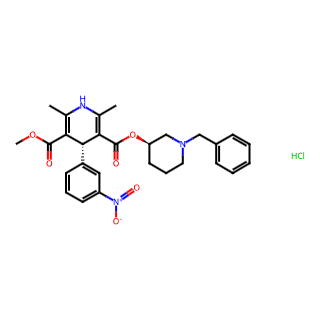- Synthetic anti-infective drugs
- Medications for the digestive system
- Antipyretic and analgesic drugs
- Medications for the blood system
- Medications for the respiratory system
- Anti-allergic drugs
- Medications for the urinary system
- Diagnostic medications
- Immunosuppressive and immunomodulatory drugs
- Vitamins and mineral supplements
- Antioxidants and medications for osteoporosis
- Antiparasitic drugs
- Ophthalmic medications
- Amino acids and their derivatives
- Dermatological medications
- Medications for the circulatory system
- Antitumor drugs
- Medications for the nervous system
- Hormonal and endocrine function-regulating drugs
- Antibiotics
- Others
CAS NO.: 91599-74-5




Basic Information
Chinese Name: 盐酸贝尼地平
English Name: Benidipine Hydrochloride
CAS Number: 91599-74-5
Molecular Formula: Typically presented as C28H31N3O6, but with the addition of HCl, it can be C28H32ClN3O6
Molecular Weight: Approximately 505.56200 (precise mass may vary slightly, e.g., 505.22100)
Isomers and Synonyms: Multiple isomers and synonyms exist.
Synonyms and Identifiers
Chinese Synonyms: 盐酸贝尼地平, (±)(R)-3-((R)-1-苄基-3-哌啶基)-5-甲基-2,6-二甲基-4-(3-硝基苯基)-1,4-二氢吡啶-3,5-二羧酸二甲酯盐酸盐, 以及其他变体。
English Synonyms: Coniel, Capadipine, KW-3049, Nacadipine monohydrochloride, and others.
Physical and Chemical Properties
Melting Point: 199-201°C
Boiling Point: 645.9°C at 760 mmHg
Flash Point: 344.4°C
pKa: 7.34 (at 25°C)
Storage Conditions: Keep in a well-ventilated, cool, and dry place, separate from foodstuffs.
Safety Information
Hazard Symbol: T
Risk Phrase (R-phrase): R25
Safety Phrase (S-phrase): S45
UN Number: UN 2811 6.1 / PGIII
RTECS Number: US7975657
Toxicity: Benidipine Hydrochloride is considered toxic. Its acute toxicity data indicates an oral LD50 of 87.6 mg/kg in rats and 322 mg/kg in mice.
Uses
Benidipine Hydrochloride is a dihydropyridine-type calcium channel blocker that binds efficiently and specifically to dihydropyridine receptors. It inhibits not only muscle-type (L-type) Ca2+ channels but also voltage-dependent N-type and T-type Ca2+ channels, making it unique in its ability to target all three channel types. Consequently, it is widely used for antihypertensive treatment and in managing renal parenchymal hypertension, angina pectoris, and other conditions.

Tai Yau Street, San Po Kong, Kowloon, Hong Kong, China.



